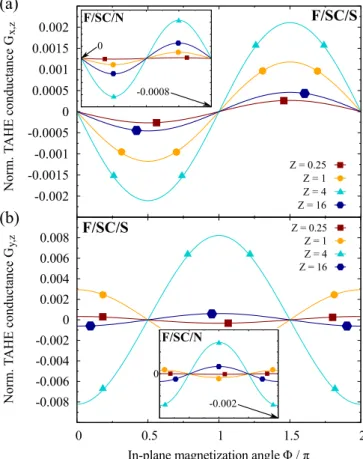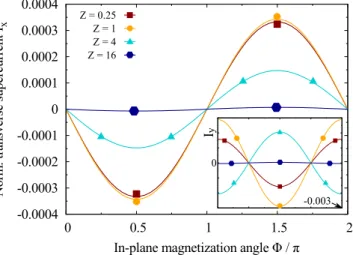Rapid Communications
Skew Andreev reflection in ferromagnet/superconductor junctions
Andreas Costa , 1,* Alex Matos-Abiague, 2 and Jaroslav Fabian 1
1
Institute for Theoretical Physics, University of Regensburg, 93040 Regensburg, Germany
2
Department of Physics and Astronomy, Wayne State University, Detroit, Michigan 48201, USA
(Received 29 May 2019; revised manuscript received 6 August 2019; published 26 August 2019) Andreev reflection (AR) in ferromagnet/superconductor junctions is an indispensable spectroscopic tool for measuring spin polarization. We study theoretically how the presence of a thin semiconducting interface in such junctions, inducing Rashba and Dresselhaus spin-orbit coupling, modifies AR processes. The interface gives rise to a momentum- and spin-dependent scattering potential, making the AR probability strongly asymmetric with respect to the sign of the incident electrons’ transverse momenta. This skew AR creates spatial charge carrier imbalances and transverse Hall currents in the ferromagnet. We show that the effect is giant, compared to the normal regime. We provide a quantitative analysis and a qualitative picture of this phenomenon, and finally show that skew AR also leads to a widely tunable transverse supercurrent response in the superconductor.
DOI: 10.1103/PhysRevB.100.060507
Due to the extraordinary properties occurring at their in- terfaces, ferromagnet/superconductor (F/S) heterostructures attract considerable interest [1–3]. Such junctions might not only offer novel tools for controlling and measuring charge and spin currents, but might also bring new functionalities into spintronics devices.
While early efforts focused on detecting spin-polarized quasiparticles in superconductors via spin transport experi- ments [4–6], current progress in the rapidly growing field of superconducting spintronics [2] opened several promising perspectives, ranging from the observation of long spin life- times and giant magnetoresistance effects [7] to the gener- ation and successful manipulation of superconducting spin currents [8–15]. But the interplay of magnetism and su- perconductivity gets even more interesting when spin-orbit coupling (SOC) of the Rashba [16] and / or Dresselhaus [17]
type is present [18,19]. Prominent examples are spin- triplet pairing mechanisms [1,20–25], leading to long-range superconducting proximity effects [26–29], and Majorana states [26,30–36], which are expected to form in supercon- ducting proximity regions in the presence of SOC.
While SOC in bulk materials plays the key role for in- trinsic anomalous Hall effects [37–41], recent theoretical studies [42–47] predicted that interfacial SOC in F/normal metal (N) tunnel junctions can give rise to extrinsic tun- neling anomalous Hall effects (TAHEs) in the N, owing to spin-polarized skew tunneling of electrons through the inter- face. The unique scaling of the associated TAHE conduc- tances could make the effect a fundamental tool for iden- tifying and characterizing interfacial SOC, thus providing the input for tailoring systems that could, e.g., host Majo- ranas. Although first experiments on granular junctions [48]
confirmed the predictions, the extremely small TAHE con- ductances remain one of the main obstacles. Sizable TAHE conductances require either interfacial barriers with large
*
andreas.costa@physik.uni-regensburg.de
SOC, such as ferroelectric semiconductors (SCs) [47], or different junction compositions.
In this Rapid Communication, we consider F/SC/S junc- tions, in which the N electrode is replaced by a S. We demonstrate that, analogously to the tunneling picture in the normal-conducting case, skew reflection [49] of spin-polarized carriers at the barrier leads to TAHEs in the F. Due to the presence of a S electrode, we distinguish two skew reflection processes: skew specular reflection (SR) and skew Andreev reflection (AR). By formulating a qualitative physical picture including both processes, we assert that skew SR and skew AR can act together and significantly enhance the TAHE com- pared to all previously studied (normal) systems. Spe- cial attention must be paid to skew AR, which transfers Cooper pairs across the barrier into the S. The electrons forming one Cooper pair are thereby also subject to the pro- posed skew reflection mechanism. We discuss that the result is a transverse supercurrent response, initially deduced from a phenomenological Ginzburg-Landau treatment [50], with widely tunable characteristics. Both findings, relatively giant TAHE conductances in the F and transverse supercurrents in the S, are distinct fingerprints to experimentally detect skew AR and characterize the junctions’ interfacial SOC.
We consider a biased ballistic F/SC/S junction grown along the ˆ z direction, in which the two semi-infinite F and S regions are separated by an ultrathin SC barrier [see Fig. 1(a)]. The barrier may be composed of a thin layer of zinc blende mate- rials (e.g., GaAs or InAs) and introduces potential scattering, as well as strong interfacial Rashba [16] and Dresselhaus [17]
SOC [18,19].
The system can be modeled by means of the stationary Bogoljubov–de Gennes (BdG) Hamiltonian [51],
H ˆ BdG =
H ˆ e ˆ S (z) ˆ † S (z) H ˆ h
, (1)
where H ˆ e = [− h ¯ 2 /(2m) ∇ 2 − μ] ˆ σ 0 − ( XC /2) (−z)
( ˆ m · σ ˆ ) + V SC d SC σ ˆ 0 δ (z) + H ˆ SOC SC δ (z) represents the
0 0.2 0.4 0.6 0.8 1
0 2 4 6 8 10
Reflection probabilities
Effective barrier strength Z eff 0
0.2 0.4 0.6 0.8 1
Reflection probabilities
SR
SR
AR
k
xz
k
yinterface
IN
AR
SR
AR
Z
k
xz
k
yinterface
IN
SR
Z
V Ferromagnet Semiconductor Superconductor V
![FIG. 1. (a) Sketch of the considered F/SC/S junction, using C 2v principal crystallographic orientations ˆx [110], ˆy [110], and ˆ](https://thumb-eu.123doks.com/thumbv2/1library_info/3740831.1509325/2.884.58.424.96.557/fig-sketch-considered-junction-using-principal-crystallographic-orientations.webp)

